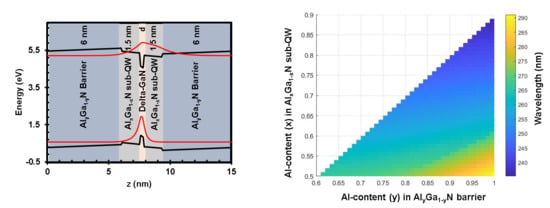AlGaN-Delta-GaN Quantum Well for DUV LEDs
Abstract
1. Introduction
2. Materials and Methods
3. Results and Discussion
3.1. Physics of AlGaN-Delta-GaN QW Designs with Different Sub-QW and Barriers
3.2. Efficiencies of AlGaN-delta-GaN QWs
4. Conclusions
Author Contributions
Funding
Conflicts of Interest
References
- Kneissl, M.; Rass, J. III-Nitride Ultraviolet Emitters; Springer: Cham, Switzerland, 2016; Volume 227, ISBN 978-3-319-24098-5. [Google Scholar]
- Seong, T.-Y.; Jung, H.; Amano, H.; Morkoc, H. III-Nitride Based Light Emitting Diodes and Applications, 2nd ed.; Springer: Dordrecht, The Netherlands, 2017; Volume 133, ISBN 978-981-10-3754-2. [Google Scholar]
- Würtele, M.A.; Kolbe, T.; Lipsz, M.; Külberg, A.; Weyers, M.; Kneissl, M.; Jekel, M. Application of GaN-based ultraviolet-C light emitting diodes—UV LEDs—For water disinfection. Water Res. 2011, 45, 1481–1489. [Google Scholar] [CrossRef] [PubMed]
- Vilhunen, S.; Särkkä, H.; Sillanpää, M. Ultraviolet light-emitting diodes in water disinfection. Environ. Sci. Pollut. Res. 2009, 16, 439–442. [Google Scholar] [CrossRef] [PubMed]
- Kneissl, M.; Seong, T.Y.; Han, J.; Amano, H. The emergence and prospects of deep-ultraviolet light-emitting diode technologies. Nat. Photonics 2019, 13, 233–244. [Google Scholar] [CrossRef]
- Takano, T.; Mino, T.; Sakai, J.; Noguchi, N.; Tsubaki, K.; Hirayama, H. Deep-ultraviolet light-emitting diodes with external quantum efficiency higher than 20% at 275 nm achieved by improving light-extraction efficiency. Appl. Phys. Express 2017, 10, 031002. [Google Scholar] [CrossRef]
- Zhang, J.; Zhao, H.; Tansu, N. Effect of crystal-field split-off hole and heavy-hole bands crossover on gain characteristics of high Al-content AlGaN quantum well lasers. Appl. Phys. Lett. 2010, 97, 111105. [Google Scholar] [CrossRef]
- Liu, C.; Zhang, J. Influence of quantum well design on light polarization switching in AlGaN ultraviolet emitters. AIP Adv. 2018, 8, 085125. [Google Scholar] [CrossRef]
- Zhang, J.; Zhao, H.; Tansu, N. Large optical gain AlGaN-delta-GaN quantum wells laser active regions in mid- and deep-ultraviolet spectral regimes. Appl. Phys. Lett. 2011, 98, 171111. [Google Scholar] [CrossRef]
- Liu, C.; Ooi, Y.K.; Zhang, J. Proposal and physics of AlInN-delta-GaN quantum well ultraviolet lasers. J. Appl. Phys. 2016, 119, 083102. [Google Scholar] [CrossRef]
- Zhang, J.; Tansu, N. Engineering of AlGaN-delta-GaN quantum-well gain media for mid- and deep-ultraviolet lasers. IEEE Photonics J. 2013, 5, 2. [Google Scholar] [CrossRef]
- Saifaddin, B.K.; Almogbel, A.; Zollner, C.J. Fabrication technology for high light- extraction ultraviolet thin- fi lm fl ip-chip (UV TFFC) LEDs grown on SiC. Semicond. Sci. Technol. 2019, 34, 035007. [Google Scholar] [CrossRef]
- Saifaddin, B.K.; Almogbel, A.S.; Zollner, C.J.; Wu, F.; Bonef, B.; Iza, M.; Nakamura, S.; Denbaars, S.P.; Speck, J.S. AlGaN Deep-Ultraviolet Light-Emitting Diodes Grown on SiC Substrates. ACS Photonics 2020, 7, 554–561. [Google Scholar] [CrossRef]
- Grandusky, J.R.; Gibb, S.R.; Mendrick, M.C.; Moe, C.; Wraback, M.; Schowalter, L.J. High output power from 260 nm Pseudomorphic ultraviolet light-emitting diodes with improved thermal performance. Appl. Phys. Express 2011, 4, 082101. [Google Scholar] [CrossRef]
- Grandusky, J.R.; Chen, J.; Gibb, S.R.; Mendrick, M.C.; Moe, C.G.; Rodak, L.; Garrett, G.A.; Wraback, M.; Schowalter, L.J. 270 nm Pseudomorphic ultraviolet light-emitting diodes with over 60 mW continuous wave output power. Appl. Phys. Express 2013, 6, 032101. [Google Scholar] [CrossRef]
- Liu, D.; Cho, S.J.; Park, J.; Seo, J.H.; Dalmau, R.; Zhao, D.; Kim, K.; Gong, J.; Kim, M.; Lee, I.K.; et al. 229 nm UV LEDs on aluminum nitride single crystal substrates using p-type silicon for increased hole injection. Appl. Phys. Lett. 2018, 112, 081101. [Google Scholar] [CrossRef]
- Zhao, H.; Liu, G.; Tansu, N. Analysis of InGaN-delta-InN quantum wells for light-emitting diodes. Appl. Phys. Lett. 2010, 97, 131114. [Google Scholar] [CrossRef]
- Verma, J.; Kandaswamy, P.K.; Protasenko, V.; Verma, A.; Grace Xing, H.; Jena, D. Tunnel-injection GaN quantum dot ultraviolet light-emitting diodes. Appl. Phys. Lett. 2013, 102, 041103. [Google Scholar] [CrossRef]
- Verma, J.K.; Protasenko, V.V.; Islam, S.M.; Xing, H.; Jena, D. Boost in deep-UV electroluminescence from tunnel-injection GaN/AlN quantum dot LEDs by polarization-induced doping. In Proceedings of the SPIE OPTO—Gallium Nitride Materials and Devices IX, San Francisco, CA, USA, 1–6 February 2014; Volume 8986. [Google Scholar]
- Islam, S.M.; Protasenko, V.; Lee, K.; Rouvimov, S.; Verma, J.; Xing, H.; Jena, D. Deep-UV emission at 219 nm from ultrathin MBE GaN/AlN quantum heterostructures. Appl. Phys. Lett. 2017, 111, 091104. [Google Scholar] [CrossRef]
- Islam, S.M.; Protasenko, V.; Rouvimov, S.; Xing, H.G.; Jena, D. Sub-230 nm deep-UV emission from GaN quantum disks in AlN grown by a modified Stranski—Krastanov mode diodes Sub-230 nm deep-UV emission from GaN quantum disks in AlN grown by a modified Stranski—Krastanov mode. Jpn. J. Appl. Phys. 2016, 55, 05FF06. [Google Scholar] [CrossRef]
- Taniyasu, Y.; Kasu, M. Polarization property of deep-ultraviolet light emission from C-plane AlN/GaN short-period superlattices. Appl. Phys. Lett. 2011, 99, 251112. [Google Scholar] [CrossRef]
- Liu, C.; Ooi, Y.K.; Islam, S.M.; Xing, H.G.; Jena, D.; Zhang, J. 234 nm and 246 nm AlN-Delta-GaN quantum well deep ultraviolet light-emitting diodes. Appl. Phys. Lett. 2018, 112, 011101. [Google Scholar] [CrossRef]
- Liu, C.; Ooi, Y.K.; Islam, S.M.; Verma, J.; Xing, H.; Jena, D.; Zhang, J. Physics and polarization characteristics of 298 nm AlN-delta-GaN quantum well ultraviolet light-emitting diodes. Appl. Phys. Lett. 2017, 110, 071103. [Google Scholar] [CrossRef]
- Liu, C.; Lee, K.; Islam, S.M.; Xing, H.; Jena, D.; Zhang, J. Demonstration of AlGaN-delta-GaN QW by plasma-assisted molecular beam epitaxy for 260-nm ultraviolet light emitting diodes. In Proceedings of the SPIE OPTO—Gallium Nitride Materials and Devices XIII, San Francisco, CA, USA, 27 January–1 February 2018; Volume 10532. [Google Scholar]
- Liu, C.; Lee, K.; Harden, G.; Hoffman, A.; Xing, H.G.; Jena, D.; Zhang, J. High Internal Quantum Efficiency from AlGaN-delta-GaN Quantum Well at 260 nm. In Proceedings of the Conference on Lasers and Electro-Optics, Washington, DC, USA, 10–15 May 2020; p. AF1I.2. [Google Scholar]
- Zhao, H.; Arif, R.A.; Ee, Y.K.; Tansu, N. Self-consistent analysis of strain-compensated InGaN-AlGaN quantum wells for lasers and light-emitting diodes. IEEE J. Quantum Electron. 2009, 45, 66. [Google Scholar] [CrossRef]
- Chuang, S.; Chang, C. k⋅p method for strained wurtzite semiconductors. Phys. Rev. B Condens. Matter Mater. Phys. 1996, 54, 2491. [Google Scholar] [CrossRef] [PubMed]
- Chuang, S.L.; Chang, C.S. A band-structure model of strained quantum-well wurtzite semiconductors. Semicond. Sci. Technol. 1997, 12, 252. [Google Scholar] [CrossRef]
- Chuang, S.L. Optical gain of strained wurtzite GaN quantum-well lasers. IEEE J. Quantum Electron. 1996, 32, 1791. [Google Scholar] [CrossRef]
- Chuang, S.L. Physics of Photonic Devices; John Wiley & Sons: Hoboken, NJ, USA, 2012; ISBN 9780470293195. [Google Scholar]
- Synopsys’s Optical Solutions Group. FullWAVE. Available online: https://optics.synopsys.com (accessed on 28 September 2020).
- Ooi, Y.K.; Liu, C.; Zhang, J. Analysis of Polarization-Dependent Light Extraction and Effect of Passivation Layer for 230-nm AlGaN Nanowire Light-Emitting Diodes. IEEE Photonics J. 2017, 9, 4501712. [Google Scholar] [CrossRef]
- Ooi, Y.K.; Zhang, J. Light Extraction Efficiency Analysis of Flip-Chip Ultraviolet Light-Emitting Diodes with Patterned Sapphire Substrate. IEEE Photonics J. 2018, 10, 1–13. [Google Scholar] [CrossRef]
- Lee, Y.J.; Kim, S.H.; Huh, J.; Kim, G.H.; Lee, Y.H.; Cho, S.H.; Kim, Y.C.; Do, Y.R. A high-extraction-efficiency nanopatterned organic light-emitting diode. Appl. Phys. Lett. 2003, 82, 3779–3781. [Google Scholar] [CrossRef]
- Palik, E.D. Handbook of Optical Constants of Solids; Academic Press: Cambridge, MA, USA, 1998. [Google Scholar]
- Zhao, H.; Liu, G.; Zhang, J.; Arif, R.A.; Tansu, N. Analysis of internal quantum efficiency and current injection efficiency in III-nitride light-emitting diodes. IEEE/OSA J. Disp. Technol. 2013, 9, 212–225. [Google Scholar] [CrossRef]
- Shatalov, M.; Sun, W.; Lunev, A.; Hu, X.; Dobrinsky, A.; Bilenko, Y.; Yang, J.; Shur, M.; Gaska, R.; Moe, C.; et al. AlGaN deep-ultraviolet light-emitting diodes with external quantum efficiency above 10%. Appl. Phys. Express 2012, 5, 28–31. [Google Scholar] [CrossRef]
- Bryan, Z.; Bryan, I.; Xie, J.; Mita, S.; Sitar, Z.; Collazo, R. High internal quantum efficiency in AlGaN multiple quantum wells grown on bulk AlN substrates. Appl. Phys. Lett. 2015, 106, 1–5. [Google Scholar] [CrossRef]
- Shatalov, M.; Yang, J.; Sun, W.; Kennedy, R.; Gaska, R.; Liu, K.; Shur, M.; Tamulaitis, G. Efficiency of light emission in high aluminum content AlGaN quantum wells. J. Appl. Phys. 2009, 105, 073103. [Google Scholar] [CrossRef]
- Murotani, H.; Akase, D.; Anai, K.; Yamada, Y.; Miyake, H.; Hiramatsu, K. Dependence of internal quantum efficiency on doping region and Si concentration in Al-rich AlGaN quantum wells. Appl. Phys. Lett. 2012, 101, 042110. [Google Scholar] [CrossRef]
- Wang, T.Y.; Tasi, C.T.; Lin, C.F.; Wuu, D.S. 85% internal quantum efficiency of 280-nm AlGaN multiple quantum wells by defect engineering. Sci. Rep. 2017, 7, 1–8. [Google Scholar] [CrossRef] [PubMed]
- Sun, P.; Bao, X.; Liu, S.; Ye, C.; Yuan, Z.; Wu, Y.; Li, S.; Kang, J. Advantages of AlGaN-based deep ultraviolet light-emitting diodes with a superlattice electron blocking layer. Superlattices Microstruct. 2015, 85, 59. [Google Scholar] [CrossRef]
- Moustakas, T.D.; Liao, Y.; Kao, C.; Thomidis, C.; Bhattacharyya, A.; Bhattarai, D.; Moldawer, A. Deep UV-LEDs with high IQE based on AlGaN alloys with strong band structure potential fluctuations. In Proceedings of the SPIE OPTO—Light-Emitting Diodes: Materials, Devices, and Applications for Solid State Lighting XVI, San Francisco, CA, USA, 21–26 January 2012; Volume 82780. [Google Scholar]
- Frankerl, C.; Hoffmann, M.P.; Nippert, F.; Wang, H.; Brandl, C.; Tillner, N.; Lugauer, H.J.; Zeisel, R.; Hoffmann, A.; Davies, M.J. Challenges for reliable internal quantum efficiency determination in AlGaN-based multi-quantum-well structures posed by carrier transport effects and morphology issues. J. Appl. Phys. 2019, 126, 075703. [Google Scholar] [CrossRef]
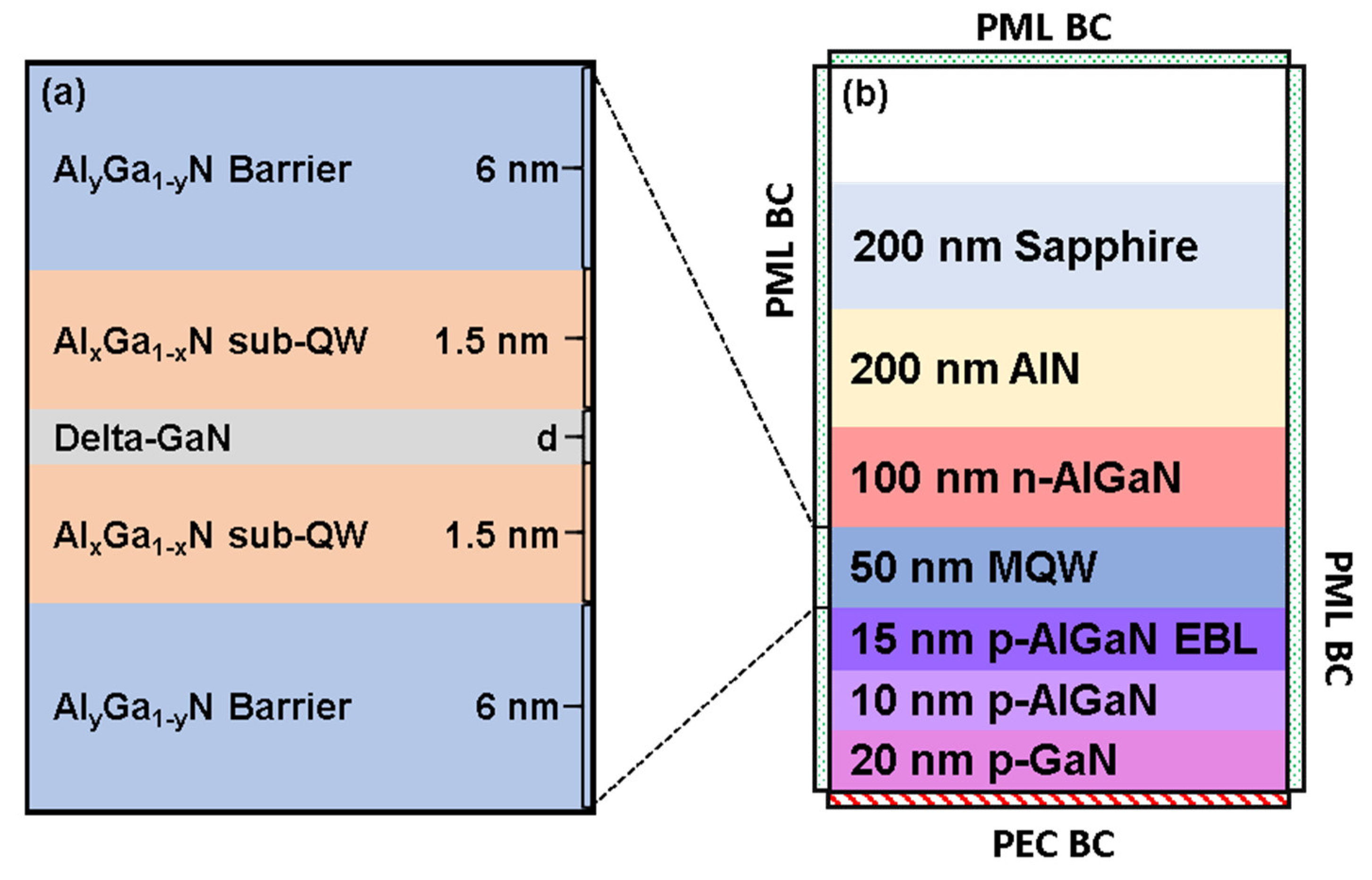

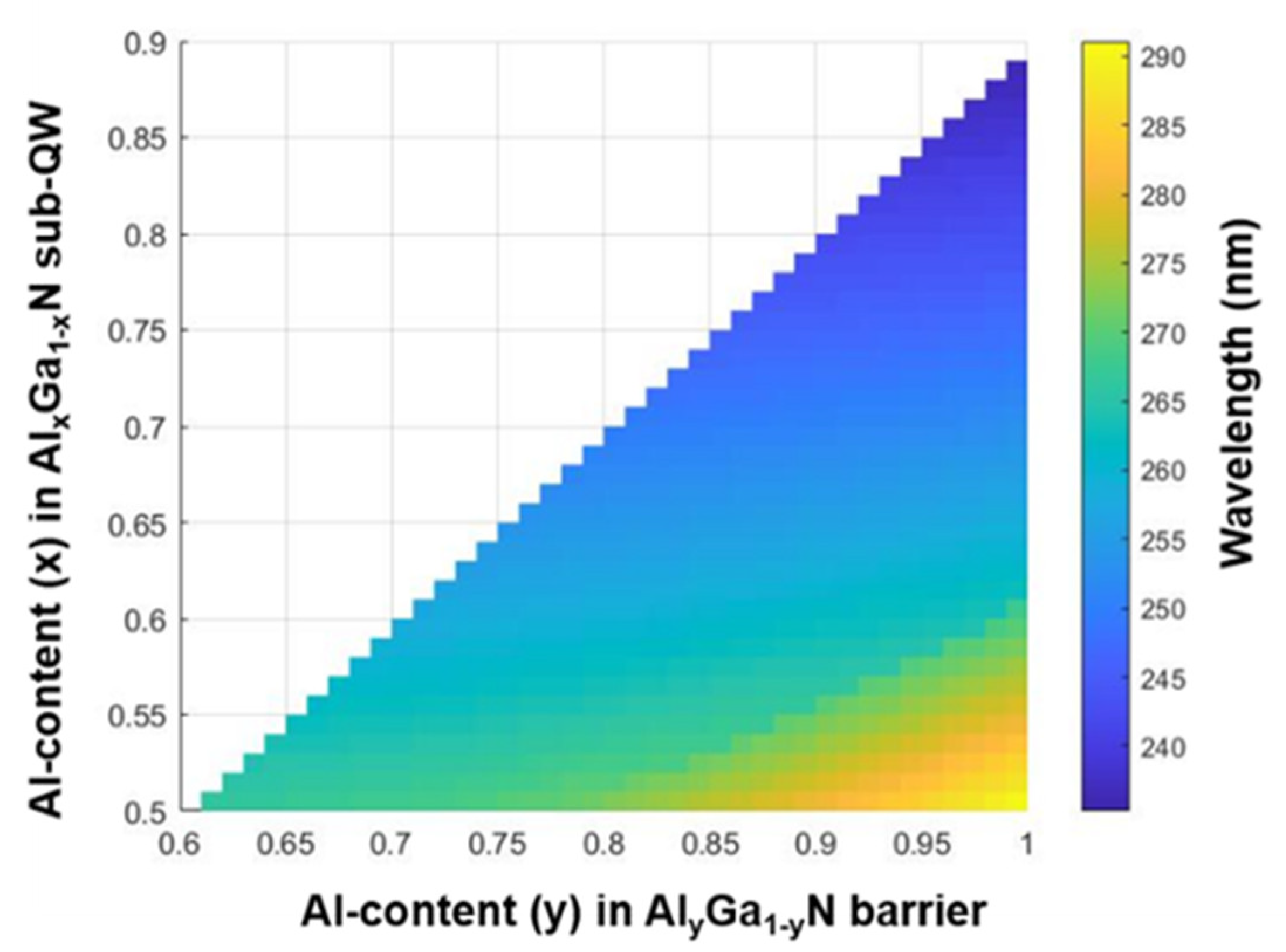
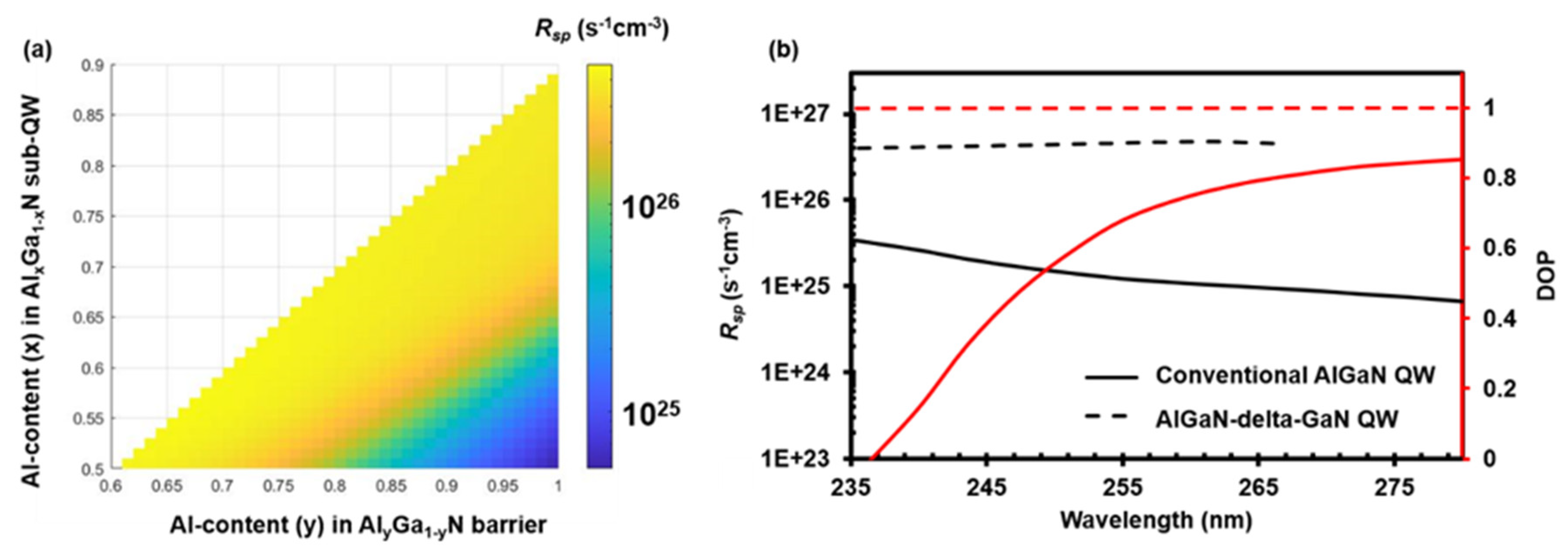
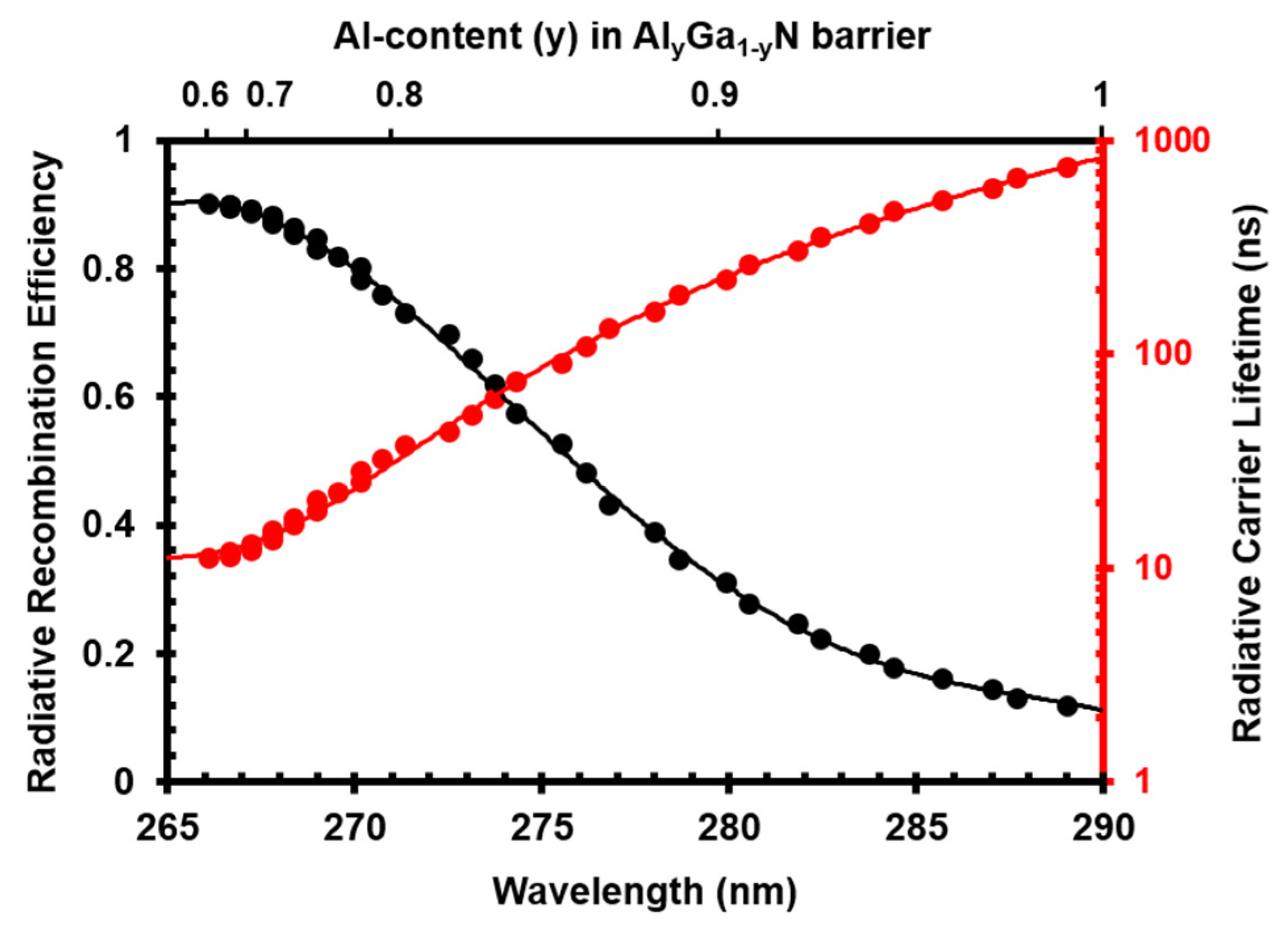
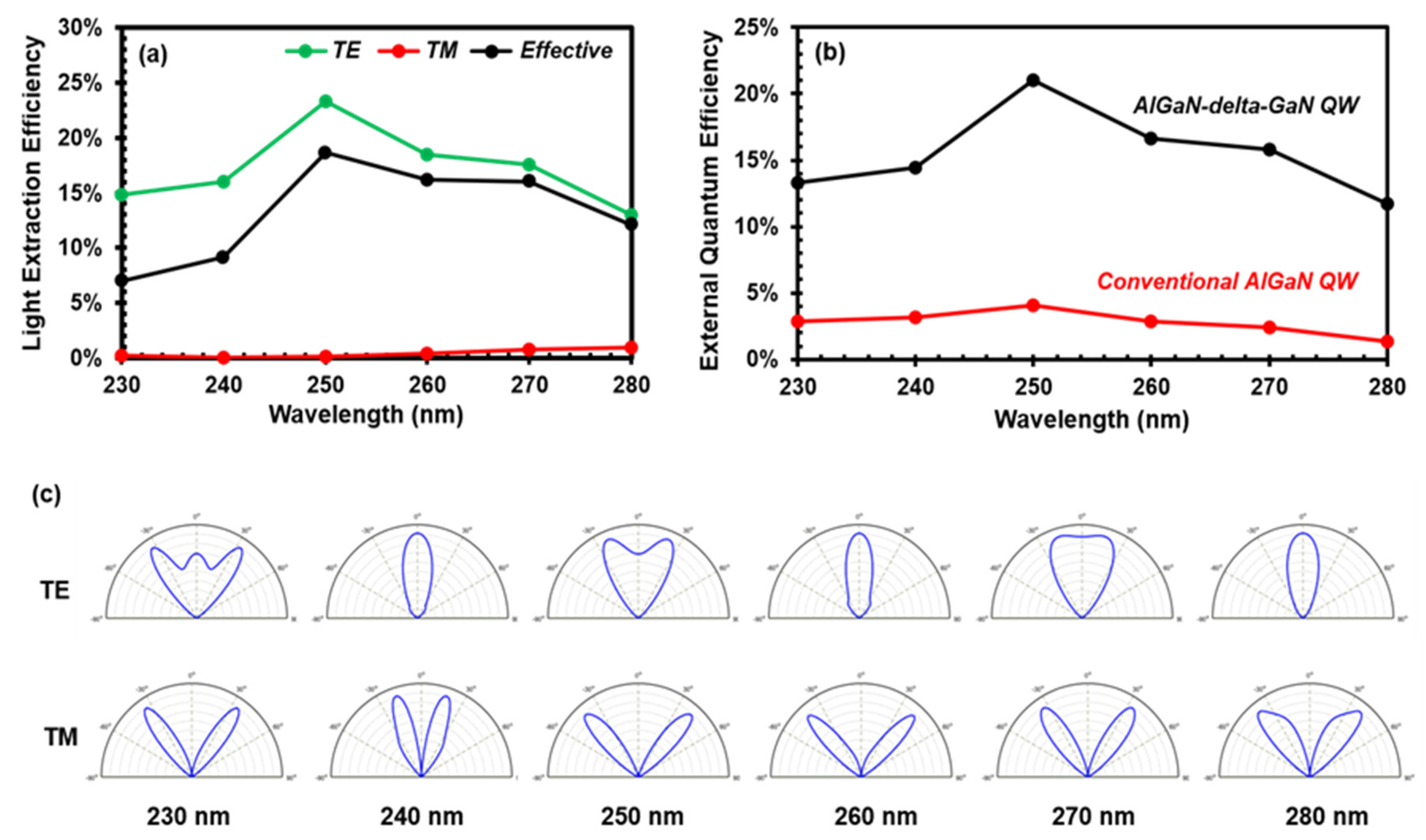
| Parameter | GaN | AlN |
|---|---|---|
| a (Å) at T = 300 K | 3.189 | 3.112 |
| c (Å) at T = 300 K | 5.185 | 4.982 |
| Eg (eV) at T = 300 K | 3.437 [31] | 6.16 [31] |
| ∆cr (eV) | 0.010 | −0.227 |
| ∆so (eV) | 0.017 | 0.036 |
| 0.21 | 0.32 | |
| 0.20 | 0.30 | |
| A1 | −7.21 | −3.86 |
| A2 | −0.44 | −0.25 |
| A3 | 6.68 | 3.58 |
| A4 | −3.46 | −1.32 |
| A5 | −3.40 | −1.47 |
| A6 | −4.90 | −1.64 |
| D1 (eV) | −3.6 | −2.9 |
| D2 (eV) | 1.7 | 4.9 |
| D3 (eV) | 5.2 | 9.4 |
| D4 (eV) | −2.7 | −4.0 |
| C11 (GPa) | 390 | 396 |
| C12 (GPa) | 145 | 137 |
| C13 (GPa) | 106 | 108 |
| C33 (GPa) | 398 | 373 |
| d13 (pm/V) | −1.0 | −2.1 |
| d33 (pm/V) | 1.9 | 5.4 |
| GaN | AlN | Sapphire | Electron Blocking Layer (EBL) | ||||||
| λ | n | k | n | k | n | k | Al Content | n | k |
| 230 | 2.756 | 0.6176 | 2.499 | 0.0275 | 1.865 | −0.026 | 0.97 | 0.022 | 2.507 |
| 240 | 2.699 | 0.5593 | 2.441 | 0.0220 | 1.855 | −0.019 | 0.96 | 0.0096 | 2.451 |
| 250 | 2.657 | 0.5188 | 2.396 | 0.0191 | 1.845 | −0.016 | 0.95 | 0.008 | 2.410 |
| 260 | 2.626 | 0.4886 | 2.362 | 0.0161 | 1.837 | −0.010 | 0.94 | 0.0062 | 2.378 |
| 270 | 2.604 | 0.4644 | 2.334 | 0.0118 | 1.830 | −0.004 | 0.93 | 0.0043 | 2.353 |
| 280 | 2.589 | 0.4435 | 2.312 | 0.0089 | 1.824 | −0.001 | 0.92 | 0.0022 | 2.334 |
| p/n/Barrier-AlGaN | Quantum Well (QW) AlGaN | Active Region n = (n1 + n2)/2 | |||||||
| λ | Al Content | n1 | k | Al Content | n2 | k | |||
| 230 | 0.86 | 2.535 | 0.0640 | 0.77 | 2.558 | 0.124 | 2.546 | ||
| 240 | 0.8 | 2.492 | 0.0477 | 0.70 | 2.518 | 0.078 | 2.505 | ||
| 250 | 0.76 | 2.459 | 0.0318 | 0.63 | 2.493 | 0.149 | 2.476 | ||
| 260 | 0.72 | 2.436 | 0.0248 | 0.55 | 2.481 | 0.128 | 2.458 | ||
| 270 | 0.68 | 2.421 | 0.0107 | 0.48 | 2.474 | 0.204 | 2.448 | ||
| 280 | 0.64 | 2.412 | 0.0067 | 0.41 | 2.475 | 0.201 | 2.444 | ||
© 2020 by the authors. Licensee MDPI, Basel, Switzerland. This article is an open access article distributed under the terms and conditions of the Creative Commons Attribution (CC BY) license (http://creativecommons.org/licenses/by/4.0/).
Share and Cite
Liu, C.; Melanson, B.; Zhang, J. AlGaN-Delta-GaN Quantum Well for DUV LEDs. Photonics 2020, 7, 87. https://doi.org/10.3390/photonics7040087
Liu C, Melanson B, Zhang J. AlGaN-Delta-GaN Quantum Well for DUV LEDs. Photonics. 2020; 7(4):87. https://doi.org/10.3390/photonics7040087
Chicago/Turabian StyleLiu, Cheng, Bryan Melanson, and Jing Zhang. 2020. "AlGaN-Delta-GaN Quantum Well for DUV LEDs" Photonics 7, no. 4: 87. https://doi.org/10.3390/photonics7040087
APA StyleLiu, C., Melanson, B., & Zhang, J. (2020). AlGaN-Delta-GaN Quantum Well for DUV LEDs. Photonics, 7(4), 87. https://doi.org/10.3390/photonics7040087






